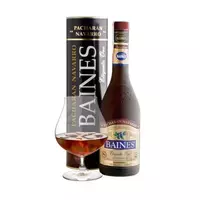Pacharan

The alcoholic beverage pacharan (Pacharan or Patxaran), whose name must be controlled by origin, is traditional for a number of areas of northern Spain. This is an alcoholic tincture of thorns berries, into which various aromatic components are added. As a rule, the alcohol content in pacharan is 20-30% (lighter species are also produced, including non-alcoholic ones), and it is served mainly as a digestif.
The first areas of pacharan manufacture were the Basque Country and Navarre. By the way, the name of this drink originates from the name of the thorn in Basque - "baso aran" (baso aran literally means "wild plum"). But over time, its production began to spread in some other regions of the country.
Regarding the first references to the manufacture and use of pacharan, we can say that they date back to the 14th century - it is on the list of drinks that were served at the wedding feasts of the kings of Navarre. Among the true connoisseurs of pacharan, Queen Blanca I of Navarre stood out, who noted the healing properties of this drink.
In the 14th and 18th centuries, pacharan was produced in a homely manner, with volumes of this beverage being relatively small. On an industrial scale, it began to be made only at the beginning of the 19th century, and a century later pacharan was considered not so much as an alcoholic drink, but as a medicinal tincture that contributed to the normalization of digestion, so then it could be purchased mainly in pharmacies.
Nationwide popularity came to this drink only by the middle of the last century. It was then that, in accordance with the requirements of the special Regulatory Council, the name "pacharan" could only be worn by a tincture that was produced exclusively in Navarre. However, to date, pacharan under the traditional name continues to be made in other regions of Spain.
In general, pacharan is considered as a kind of hybrid of anise tincture and liquor. From a technological point of view, this drink is a blend of sugar syrup, alcohol tincture of terna berries and anise. In addition, in the production of pacharan, small amounts of additives of various aromatic essences are used - mainly fruit or vanilla, sometimes caramel.
Depending on the percentage of sugars, pacharan is both sweet and dry. If the thorn-anise tincture is presented in its pure form, it differs in dark red or brownish color. The addition of aromatic essences to the drink helps to color the liquid in a wide variety of colors and shades: pink, yellow, purple, blue and others.
According to tradition, serving pacharan is accepted after a meal as a digestif. It is poured into small stacks or glasses, often served simultaneously with coffee. This drink is recommended to be consumed in chilled form, however, for this, do not put ice inside the glass, but put the bottle with pacharan in the cold in advance. Alternatively, you can serve glasses with a drink in small cups that are filled with crushed ice. By the way, in a number of Spanish restaurants, upon completion of the meal, you can offer inexpensive varieties of pacharan for free - as a "compliment" from the institution.
pacharan 299 kCal
Energy value of pacharan (Ratio of proteins, fats, carbohydrates - ju):
Proteins: 0 g (~ 0 kCal)
Fats: 0 g (~ 0 kCal)
Carbohydrates: 40g (~ 160kCal)
Energy ratio (bj | y): 0% | 0% | 54%
 Español
Español Français
Français Português
Português Русский
Русский 简体中文
简体中文 繁體中文
繁體中文 日本語
日本語 한국어
한국어 العربية
العربية Türkçe
Türkçe Қазақ
Қазақ Deutsch
Deutsch Italiano
Italiano Українська
Українська
